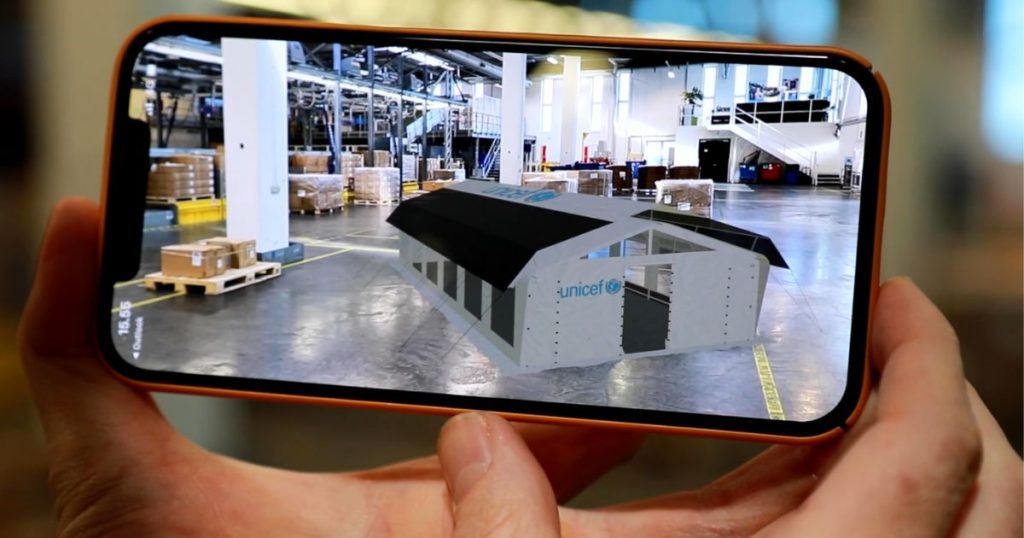With Artificial Intelligence (AI) ‘s rapid development, augmented reality (AR) is considered one of the practical applications in many industries nowadays. However, many people have no idea about “how does AR work”.
In fact, when a user aims the device at an object, the program detects it using computer vision technology to offer users a hybrid between the real and the digital. If you need clarification about the operation of this cutting-edge technology, this article will show you.

What Is Augmented Reality?
Augmented Reality, or AR, is a technology using an AR device to overlay digitally created 3D objects in real-world environments. When the user looks at the screen, they will see both the physical object and the information offered by AR software in 3D.

For example, with the immersive application in furniture, users can see several furniture pieces in 3D by focusing their phones on a specific area in a room. This significant application will make the selection process more straightforward because they can see how the actual furniture would appear in their house.

There is a lot of 3D modeling provider in the world nowadays, who offer augmented reality services for businesses wanting to engage their customers by blurring the boundary between the physical and digital world. These kinds of services will help some enterprises gain more clients, improve conversion rates and reduce return rates.
How Does Augmented Reality Work?
AR works based on camera-equipped device such as a smartphone, tablets, or smart glasses. It is loaded with AR software. When a user points these devices at an object, computer vision technologies in the program will analyze the video stream to detect it.

The device then gets information about the object from the cloud, just like a web browser loads a page through a URL. The AR information is displayed as a 3-D “experience” superimposed on the object rather than a 2-D page on a screen, which is a significant change. What the user sees is thus a hybrid of the real and the digital.
AR may display real-time data from objects and let users operate them through touchscreen, voice, or gesture. A user, for example, might touch a stop button on a digital graphic overlay within an AR experience—or say the word “stop”—to send a command to a product via the cloud. An operator interacting with an industrial robot using an AR headset may view overlay data on the robot’s performance and have access to its controls.

The size and angle of the AR display dynamically adapt to the changing context as the user moves. New graphical or textual information appears, while older information fades away. Users working in different fields, such as machine operators or maintenance professionals, can enjoy different AR experiences while working with the same object.
What is the Difference Between AR, VR, and MR?
Augmented Reality uses a smartphone’s camera to overlay digital components on a live scene. Two outstanding examples of augmented reality experiences are Snapchat glasses and the Pokemon Go game.

On the other hand, Virtual Reality is an entirely immersive experience that isolates the user from the outside environment. Users may be transported into different real-world imagined environments, like the center of a squawking penguin colony or the back of a dragon, by utilizing VR devices such as HTC Vive, Oculus Rift, or Google Cardboard.

Real-world and digital objects interact in a Mixed Reality (MR) experience, including AR and VR components. Mixed Reality is also being utilized to superimpose VR real-world people into video games, bringing real-world personalities to game streaming sites such as Twitch or YouTube. “ How does mixed reality work” is a question many want to ask when running into this term. Mixed Reality processes data about an area using a set of cameras, sensors, and typically AI-enabled technologies to produce digitally augmented experiences.
Related article: augmented reality vs virtual reality
2 Types Of Augmented Reality
In fact, there are different types of augmented reality available in the market nowadays. Especially. two types of AR used frequently in many industries are marker-based AR and markerless AR, with the former being the most basic version. There are also four forms of markerless AR: location-based AR, projection-based AR, overlay AR, and contour AR.
Maker-based AR
A visual marker in marker-based AR activates the transformed, interactive experience. Two-dimensional QR codes are the most often used markers. The camera on a device reads the machine-readable barcode and responds by providing visual effects.

While marker-based augmented reality was once revolutionary, it has significant limitations. Typically, users can use this technology via mobile devices such as smartphones or tablets. Therefore, they must download the app or program to view the information, so it needs more instant gratification than we’ve grown accustomed to in today’s digital world.
Markerless AR
While marker-based AR works based on image recognition, markerless AR, on the other hand, does not require this to achieve visual effects. Instead, the technology detects positional information using a device’s camera, location software, and accelerometer, including the direction of distinct objects and the space between them.

Creating markerless AR is undeniably tricky. However, the technology rapidly surpasses its marker-based counterpart as the preferred option among forward-thinking manufacturers and aggregators. The two primary forms of markerless AR are projection-based and location-based, besides overlay and contour-based forms.
4 Essential Components For AR To Work
AR works smoothly or not, depending on four main essential components. The following are the primary hardware components necessary for conducting AR applications and their functions you should know:
- Computer: besides creating virtual content and controlling all devices, the computer must collimate the virtual scope and the observer’s location to the scene based on information from the tracking system.
- Display devices: There are three types of display devices, based on the location of the user and the viewed object: Head-Mounted Display (HMD), which is on the user’s head; Hand-Held Display (HHD), which is similar to a tablet or mobile phone; and Spatial Displays (SD).
- A tracking system: This is required to capture and record the user’s location and direction in space so that the virtual picture may be appropriately aligned with the real one.
- Interactive tools: Users can use interactive tools such as touchpads or wireless as additional input devices.
3 Applications of Augmented Reality
Augmented Reality has been applied to various fields, such as the medical, manufacturing, and engineering industries. However, there are three main applications of this technology that make it popular in the world today. Keep reading to see what they are:
Maintenance And Repairing
Maintenance and repair tasks need various AR applications that use numerous overlay techniques and hardware. People can complete the machine maintenance process faster and with fewer mistakes using AR, which minimizes average repair time, increases equipment availability, and reduces unscheduled downtime.

One of the specific advantages of AR is fastening issue diagnosis by spending less time identifying important components and referring to schematics.
Product Design And Development
AR technology may save stakeholders a lot of time at each level of the product design process, allowing them to deploy technologies with no time lag. A product designer, for example, might predict their results in the real world to determine whether or not it is realistic to proceed to the next stage.

AR helps leverage the observation and understanding of each geographical environment and the happening activities surrounding the object. It can assist in accelerating the investment by allowing diverse stakeholders to witness the functioning model and the advantages realized virtually. Furthermore, the technology can speed up the development process, especially when combined with other prototyping approaches.
Training
AR technology in the workplace can improve the learning and comprehension of both new and experienced employees. Furthermore, AR may increase employee engagement and safety awareness, save training expenses, and shorten learning curves.
In particular, AR offers hands-on learning in an organized, interactive environment. Physical devices enable trainees to practice work tasks in real-time, at their speed, and without being pressured by customers, management, or performance expectations.
Some jobs are inherently risky, and training for them may be just as dangerous. As a result, AR enables new employees to perform these jobs without risk of damage or endangering themselves.
Frequently Asked Questions
What software is used for augmented reality?
It depends on the category of AR technology. For instance, if you want to ask for the software used in AR development toolkits, it will be Vuforia Augmented Reality SDK. Meanwhile, the software used for AR content management systems can be Web – AR Studio.
What technology is used in augmented reality?
Some great technologies that have been used in augmented Reality are Simultaneous Localization and Mapping ( SLAM) technology, depth tracking technology, and natural feature tracking technology.
What are the three elements of augmented reality?
Three augmented reality elements are:
- Integration of the digital and physical worlds
- Real-time interactions
- Precise 3D identification of virtual and actual objects
Conclusion
As you can see, although the operation of augmented reality is complicated, it is still one of the proudest achievements of the AI field. Many people forecast that this state-to-the-art technology will continue to develop globally in the future. Hopefully, you will receive the most apparent answer to the question “How does augmented reality work” after reading this article.

Related Posts: